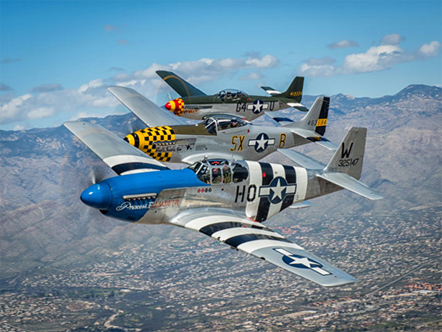 <><><><>
<><><><>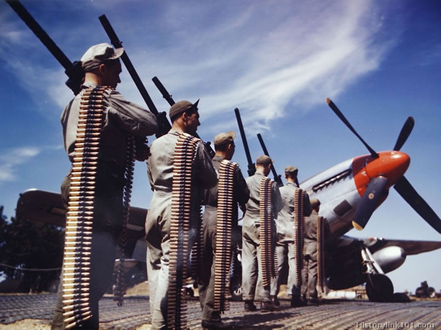
 <><><><>
<><><><>
Considered the finest Allied fighter produced during WW II, the P-51 originated with an April 1940 proposal to the British Aircraft Purchasing Commission by the chief designer of North American Aviation, J.H. (“Dutch”) Kindleberger, to design a fighter from the ground up rather than produce another fighter, the Curtiss P-40, under license. The result was a trim low-wing monoplane powered by a liquid-cooled in-line Allison engine. Other fighters powered by non-turbo-supercharged Allisons, notably the P-40 and P-39, had shown mediocre performance, and the U.S. War Department had reserved turbo-supercharger production for four-engined bombers (the P-38 Lightning being the only exception at that point).
Nevertheless, by using experimental data obtained from the U.S. National Advisory Committee on Aviation, Kindleberger’s team achieved a giant leap in performance. Their design, dubbed Mustang by the British, had a low-drag laminar-flow wing and an efficient low-drag engine cooling system that gave it exceptional speed and range. The only drawback was the Allison’s lack of an efficient high-altitude supercharger, which restricted the plane to low-altitude operations below 15,000 feet (4,600 meters).
The Mustang first flew in October 1940, entered production in May 1941, and began combat operations with the RAF in April 1942. Some 1,579 Allison-powered Mustangs were produced. They were typically equipped with two .50 cal nose-mounted and four .30 cal wing-mounted machine guns, although one model had four 20 mm cannons and another (the A-36A) was a dive-bomber for the USAAF. They served as low-altitude fighters and as long-range photo-reconnaissance aircraft under the designation F-6, mostly with the RAF.
In the meantime, the British had experimented with Mustangs fitted with the powerful Rolls-Royce Merlin engine, and they discovered that the Merlin’s efficient mechanical supercharger gave the fighter outstanding high-altitude performance. North American quickly followed suit. The Merlin was already being produced under license in the United States by the Packard Motor Company, and by the summer of 1943 Packard Merlin-powered P-51s were coming off North American’s assembly line.
Merlin-powered P-51s, equipped with jettisonable drop tanks, had an operational range of more than 1,600 miles (2,500 km), and they mounted their first long-range bomber escort missions over Germany in mid-December 1943. They quickly established superiority over Germany’s premier fighters, the Me 109 and the Fw 190, particularly evident above 20,000 feet (6,000 meters). By March 1944, P-51s were available in quantity and, in combination with drop tank-equipped P-47 Thunderbolts and P-38s, had gained the advantage over the Luftwaffe in the daylight skies over Germany.
The crippling losses which the U.S. bombers had previously suffered were thereafter drastically reduced: in October 1943 as many as 9.1 percent of the Eighth Air Force bomber sorties credited with attacking their targets had failed to return, and a further 45.6 percent had been damaged. In February 1944 the corresponding figures fell to 3.5 percent and 29.9 percent. From that point, Germany was effectively under round-the-clock bombardment. Though fewer in number, the P-51 could penetrate deeper into German airspace than the other U.S. fighters and was better in air-to-air combat; it thus played a disproportionately large role in the defeat of the Luftwaffe.
Approximately 1,500 Merlin-powered Mustangs were used by the RAF for daylight duties over Europe, and the plane was produced under license in Australia toward the end of the war. A few were delivered to Nationalist China. The most widely produced version was the P-51D. Hard points below each wing allowed the P-51D to be fitted with 500-pound (230-kg) bombs or three-shot 4.5-inch (114-mm) rocket launchers, bolstering its capabilities as a close air support platform.
Beginning in the spring of 1945, later versions of the Mustang designed for extremely long-range operations flew over Japan from bases in the Marianas Islands. The photo-reconnaissance version of the Mustang, the F-6, was used in all theatres of the war by both the USAAF and the RAF. Unlike photo-reconnaissance versions of the P-38, the F-6 retained its armament, being used primarily in low-altitude operations where it might have to defend itself.
About 13,300 Merlin-powered Mustangs were produced in the United States. Though production contracts were canceled at war’s end, the P-51 remained in service with the Air Force for several years thereafter. P-51s, some taken out of “mothballs,” were used for ground-attack missions early in the Korean War (1950–53). Mustangs also were used by Nationalist forces in the Chinese Civil War and by Israel in the 1956 Sinai invasion. P-51s continued to serve in less-developed countries into the 1960s and last saw combat in Salvadoran hands during the 1969 Soccer War with Honduras.
North American Aviation built 15,575 P-51s (all variants) in their Inglewood, California and Dallas, Texas plants. Today, approximately 150 P-51s are airworthy and they are a popular airplane for air racing. There are also many P-51s found in air museums throughout the world.
Facts and General Characteristics of the P-51D Mustang):
Contractor: North American Aviation
Type: Fighter/bomber
Crew: One
Wingspan: 37 ft. 0. in (11.28 m)
Length: 32 ft. 3 in. (9.83 m)
Height: 13 ft. 4½ in. (4.08 m)
Weight: Empty 7,635 lbs. (3,465 kg), Max Takeoff 12,100 lbs. (5,490 kg)
Power Plant: 1,490 hp Packard V-1650-7 liquid-cooled V-12, with a 2 stage intercooled supercharger
Max speed at 25,000 ft: 440 mph (708 km/h)
Ceiling: 41,900 ft. (12,800 m)
Range: 1,650 mi (2,655 km) with external fuel tanks
Armament: Guns: 6 × 0.50 caliber (12.7mm) AN/M2 Browning machine guns with 1,840 total rounds (380 rounds for each on the inboard pair and 270 rounds for each of the outer two pair). Rockets: 6 or 10 × 5.0 inch (127 mm) T64 H.V.A.R rockets. Bombs: 1,000 lb. (453 kg) total on two wing hardpoints. Each hardpoint: 1 × 100 lb. (45 kg) bomb, 1 × 250 lb. (113 kg) bomb or 1 × 500 lb. (226 kg) bomb).
Facts and General Characteristics of the Model:
The model represents the P-51D Mustang “Big Beautiful Doll” with external fuel tanks flown by Col. John D. Landers while assigned to the 84th Fighter Squadron, 78th Fighter Group based in Duxford, England. On the left hand side of the fuselage is the kill tally for Colonel Landers. In total there are 36.5, of which 6 are Japanese aircraft, 14.5 are aerial and the remainder are ground victories. The half kill is for a shared downing of a Messerschmitt Me 262 on 30 March 1945.
Manufacturer: Revell Inc.
Scale: 1/48
Wingspan: 9”
Length: 8”
Height: 3.2” (tip of prop blade)
Parts: 49
Decals: 65
Hours to build and paint: 18.5
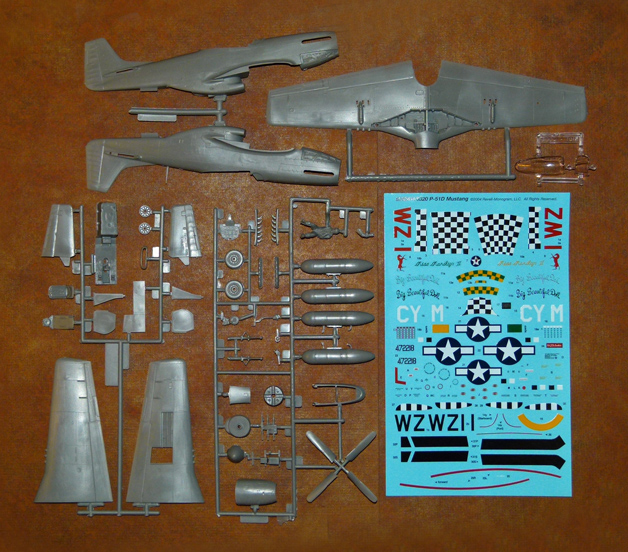
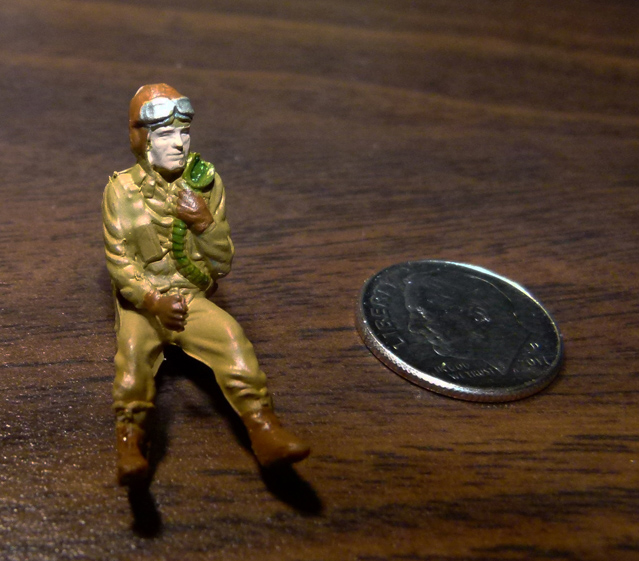
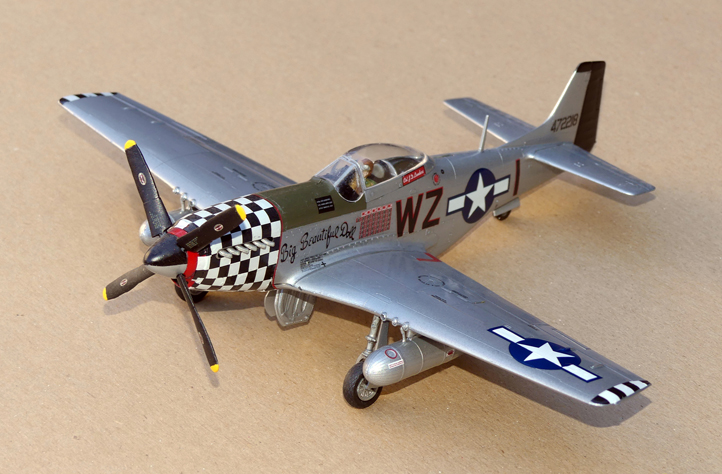



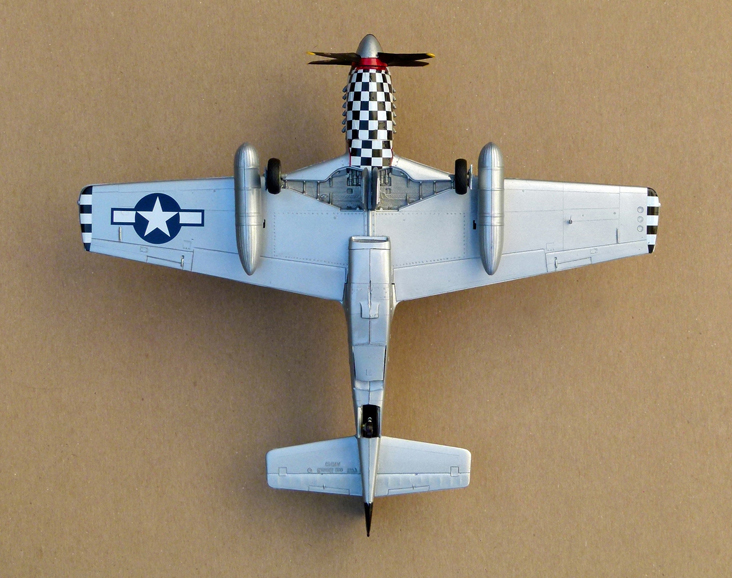

Wing panel open exposing three .50 cal AN/M2 Browning machine guns and 920 rounds of ammunition.